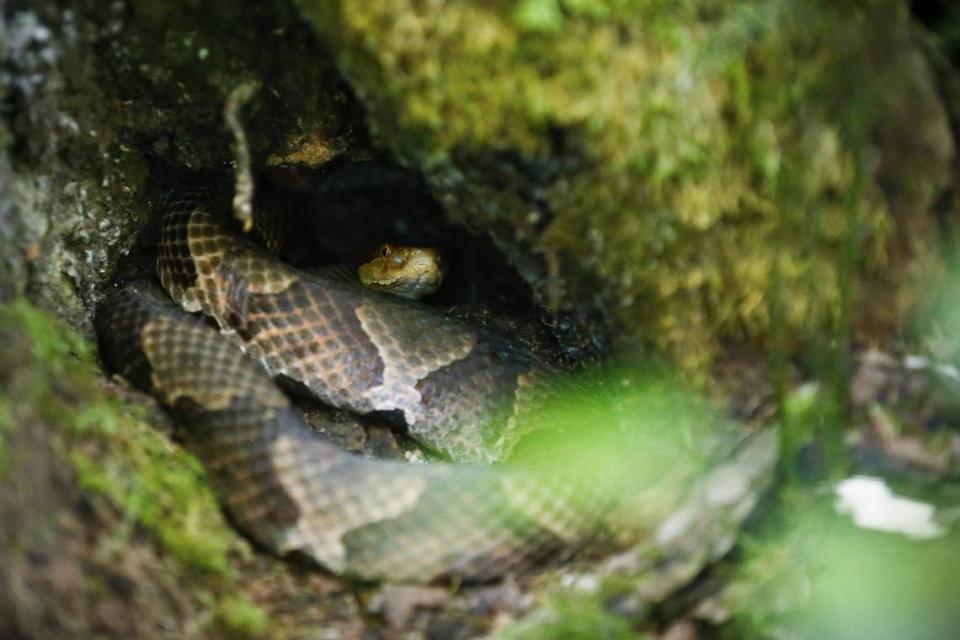Slithering snake on your KY deck? What an expert recommends to keep them out of your yard
If you’ve spent any amount of time outdoors in Kentucky, there’s a good chance you’ve encountered a snake. The sight of one undulating across your lawn or along a hiking trail sparks surprise in many and sheer terror in some.
You’re probably content to let them do their own thing — away from you. Things get more complicated when you cross paths, however.
To be clear, most snakes in Kentucky aren’t venomous and pose no threat to humans. Venomous animals have to bite or sting you to do harm, whereas poison does harm once it is ingested. Even if you are bitten by a venomous snake, as rare as that is, there’s a good chance you got a “dry bite” that doesn’t include venom.
There are also many benefits to having snakes around. That said, if you want to limit your encounters with them, venomous or not, there are steps you can take.
To get at that question, we asked Steven Price, a professor of stream and riparian ecology at the University of Kentucky, for some tips.
What are some common hiding spots for snakes in backyards?
As both predators and prey, snakes are generally shy and reclusive animals. Doubly so when it comes to encounters with humans.
“They’re terrified of you. They think of you as a giant predator,” Price said.
Most of the time, a snake is either looking for a meal, searching for a nice spot to sun itself or trying to find a mate, Price added.

If your yard can meet at least one of those basic needs for a snake, there’s at least a chance of finding one. According to Price, some potential draws for snakes include:
Tall grass, thick vegetation and other plants that offer cover.
Water sources like rivers and streams. Those could be a draw for water queensnakes or garter snakes, neither of which are venomous.
Wood piles, rock walls and similar debris.
Feeders that can draw small birds or rodents that are prey for snakes.
Quiet storage areas, like basements or crawl spaces, which can serve as safe spaces for snakes to overwinter or shed their skin.
Underneath structures, such as a backyard deck. According to Price, it’s not unheard for a snake to sun itself on a deck. More typically though, decks provide a structure they can quickly duck under if needed.
Dog get bitten by a snake? Here’s what to do, next steps if the vet isn’t nearby
What’s the best way to keep snakes away from your property?
If you want to minimize your interactions with snakes, the best thing you can do to keep them out of your yard is to declutter.
Keep your yard well-maintained. That means cutting down tall grasses and trimming bushes. Manicured lawns with lots of mulch landscaping “really doesn’t provide that great of a snake habitat,” according to Price. Eliminating any piles of rock or wood is also a good idea.
Remove potential food sources. Know that if you feed wildlife, such as birds, squirrels or chipmunks, you could indirectly draw snakes to your yard. If you’re worried about that, Price recommends putting away your bird feeders in the summer months when snakes are most active. It’s also generally a good idea to secure your garbage bin, clean up spilled birdseed and avoid leaving pet food outside.
Inspect any storage areas that could be attractive shelters for snakes and seal up cracks. A telltale sign of snake activity is shed snakeskin, which the animals like to do in secluded areas where they won’t become prey.
Where do KY’s copperheads, other snakes go in the winter? You’ll want to clean your yard
What should I do if I find a snake in my backyard?
Unless you’re certain it’s venomous, and in Kentucky there are only four venomous snake species, you likely don’t need to do anything.
Price recommends taking the opportunity to observe the snake. If its presence makes you uncomfortable, encourage it to move along without resorting to violence.
If you’re not sure whether it’s one of Kentucky’s venomous snakes — copperheads, cottonmouths, timber rattlesnakes and pigmy rattlesnakes — UK offers a free tool for identifying snakes. The university also has images of every snake species in Kentucky.
If it is a venomous snake and you want it gone, Price recommends turning to a wildlife removal service.
Do you have a question about critters and wildlife in Kentucky for our service journalism team? Send us an email at ask@herald-leader.com or submit your comment or question via the Know Your Kentucky form below.

